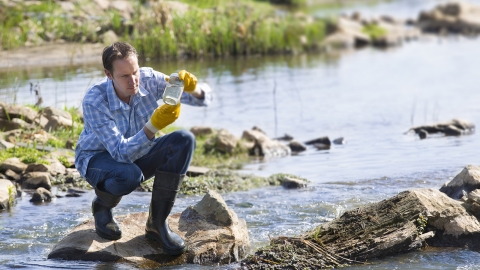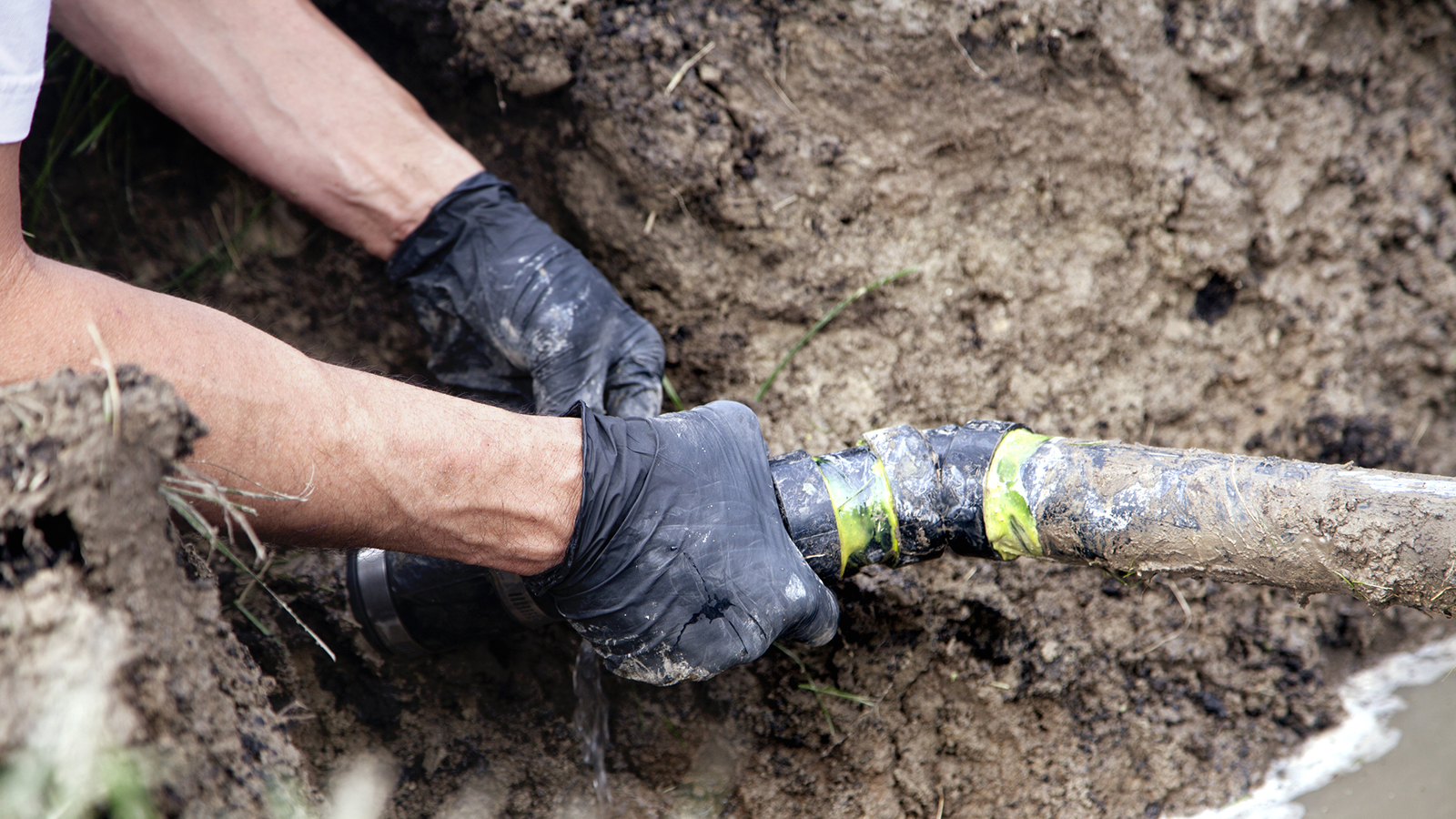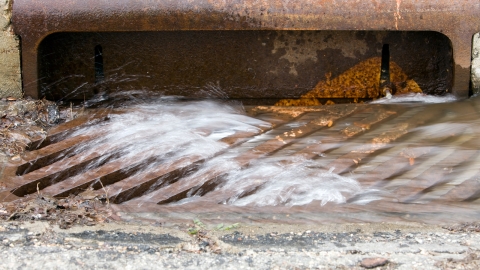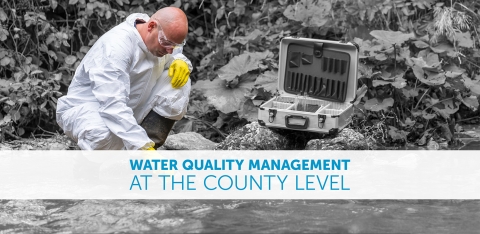Water Quality Management at the County Level
Upcoming Events
Related News
Introduction
Water and wastewater systems across the U.S. are rapidly reaching the end of their useful lifespans i and are facing a growing number of challenges resulting from aging infrastructure, increased federal and state requirements and rising costs to meet infrastructure needs and environmental mandates. According to the American Society of Civil Engineers’ 2017 Infrastructure Report Card, the nation’s drinking water and wastewater infrastructure are rated a D and D+, respectively. Additionally, per the 2017 County Health Rankings, more than half of all counties in the U.S. were reported to have had the presence of at least one health-related drinking water violation. ii
In order to remain healthy, vibrant, safe and economically competitive, America’s counties must be able to upgrade and modernize their water and wastewater systems to meet the increased water quality and storm water management requirements as outlined in the Clean Water Act (CWA) and the Safe Drinking Water Act (SDWA). Compounding this issue, while the estimated amount needed to upgrade these systems is between $384.2 billion and $1 trillion by 2030 for drinking wateriii and $271 billion by 2021 for wastewater systems,iv annual federal appropriations to meet federal standards, via the clean water and drinking water state revolving funds, has been holding steady at approximately $2 billion a year. This lack of growth amidst increasing need has required state and local governments to increase their spending substantially. In fact, 96 percent of all public spending on water and wastewater utilities ($105 billion) in 2014 was by local and state governments.v In 2016, counties spent a total of $122 billion on building public infrastructure and maintaining and operating public works, $22 billion was spent on sewerage and solid waste management alone.
Despite facing further budget shortfalls, counties continue working to protect and improve the quality of local water systems, watersheds, rivers, streams, lakes and aquifers. As systems continue to deteriorate, counties must become more creative as they seek new, innovative ways to meet the water needs of their residents.
Printable PDFThe Water Cyclevivii
As we know, water has three main forms: solid, liquid and gas. Water leaves the earth in a gaseous state and (re)enters as a liquid, via rain, or solid, via snow and sleet. When water enters the earth, it can become either groundwater or surface water.
Groundwater, which makes up thirty percent of the Earth’s fresh-water supply, is found beneath the Earth’s surface. Stored in underground aquifers, the water must be pumped out of the ground via wells. Groundwater also naturally moves through aquifers to eventually be discharged as surface water. Approximately forty percent of our nation’s drinking water comes from groundwater.
Surface water includes oceans, rivers, streams, lakes and wetlands, to name a few. The amount of surface water is constantly changing due to inflows (water entering the supply) and outflows (water exiting the supply). One type of common inflow—besides groundwater—is stormwater runoff, which occurs during a storm when the ground is already saturated or has impervious surfaces such as parking lots, roads, driveways, sidewalks, etc. In urban and suburban areas especially, stormwater runoff can often contain a number of pollutants, which can degrade local water resources.
Surface and stormwater drain from one body of water to another based on the region’s watershed. If this water has high levels of pollutants, it can cause water quality issues further downstream. Common pollutants include nitrogen and phosphorous from fertilizers, yard waste and—occasionally due to combined sewer overflows—wastewater. To ensure surface water quality, watersheds are monitored and assessed by the U.S. Environmental Protection Agency (EPA) through the Clean Water Act (CWA)viii. The Clean Water Act establishes the basic structure for regulating discharges of pollutants—including wastewater—into “Waters of the United States (WOTUS)ix in order to protect water and wetland habitats and the safety of drinking and recreational waters. Many of these federal regulations directly impact county governments.

Water Systems
The U.S. Department of Homeland Security estimates that there are just over 153,000 public drinking water systems in the United States that provide potable water to almost 90% of the population (just under 300 million people) and more than 16,000 wastewater treatment systems that service 75% of the population.x 47% of community (drinking) water systems are locally government owned—primarily by cities.xi
Drinking water—the quality of which is monitored by the EPA through the Safe Drinking Water Act (SDWA)—can be sourced from either groundwater or surface water depending on the location of drinking water systems. Typically, urban community water systems draw from surface water sources while rural community water systems draw from ground water via wells.xii Drinking water can be easily compromised. As such, it is vitally important that counties take proper precautions to ensure the safety and security of their water supply and distribution systems.
20% of Americans dispose of their wastewater via septic tanks, which drain into groundwater
Water distribution systems, a series of interconnected pipes, storage facilities and other components that transport drinking water, originate at either a water treatment plant or at the source. They span almost one million miles in the United States, and if deteriorating or contaminated, can pose a major public health risk.
The Clean Water Act (CWA) establishes the basic structure for regulating discharges of pollutants into the waters of the United States and regulating quality standards for surface waters.
Waters of the U.S., or WOTUS, is a term used in the Clean Water Act to define which waters (and their tributaries) fall under federal or state jurisdiction. The U.S. Environmental Protection Agency (EPA) and the U.S. Army Corps of Engineers (Corps) have undertaken an effort to revisit and rewrite the WOTUS rule which was finalized in 2015.
Total Maximum Daily Loads (TMDLs) are water quality criteria that act as goals or targets for watershed restoration plans. A TMDL calculates the pollution cap for a given water body, and the term TMDL has come to imply both the cap itself as well as the restoration or management plan needed to meet this goal. Meeting TMDL goals prevents or reduces pollution in an âimpairedâ water body, sufficient to meet water quality criteria and support uses. Under the Clean Water Act, âEach state shall identify those waters within its boundaries for which the e uent limitations [for industrial and municipal wastewater] are not stringent enough to implement any water quality standard applicable to such waters.â
Combined Sewer Overflow, or CSOs, are often misunderstood. They do not discharge untreated sewage into surface waters during heavily rain fall. All water is treated but the waters that âoverflowâ go around the primary treatment plant to a secondary treatment plant which may not treat to the standard of the higher primary treatment plant but the waters are still treated. Once treated, the secondary treatment plant waters are mixed with those treated at the primary treatment plant and then discharged to surface water sources.
The County Role
In the arena of CWA, counties play a dual role as both co-regulators and regulated entities in protecting the environment and providing public water services for our residents and businesses. As regulators, counties are often responsible for controlling water pollution at the local level. They may enact rules on illicit discharges, remove septic tanks and adopt setbacks for land use plans. They may be responsible for water recharge areas, green infrastructure, water conservation programs and pesticide use for mosquito abatement. Counties also provide extensive outreach and education to residents and businesses on protecting water quality and reducing water pollution.
Counties spent $22 billion on sewage and solid waste management in 2016.
Additionally, counties own and maintain vast amounts of public infrastructure, including 45 percent of America’s road miles, nearly 40 percent of bridges, drinking water utilities, wastewater treatment plants and stormwater infrastructure - all of which are subject to federal water CWA rules.
Case Study:
Clackamas County, Ore.xiii
While Clackamas County, Oregon, is considered relatively urban with a population close to 400,000, it has a sizable rural component. Much of the county draws its water from the Clackamas River for a multitude of uses, including for residential drinking water and for agricultural purposes. The county itself manages two sewer districts and operates five wastewater treatment facilities (WWTP) that serve more than 165,000 people through Clackamas County Water Environment Services (WES).xiv There are also eight different public water providers in Clackamas County—and neighboring Washington County—that own five different water treatment plants (WTP) and service around 300,000 people with clean drinking water.
With the number of residents and businesses dependent on the Clackamas River Watershed, there is a high need for stakeholder collaboration to ensure it remains healthy. With that in mind, in 2007, the Clackamas River Water Providers (CRWP) was formed to protect and conserve the county’s drinking water sources.xv Prior to the formation of CRWP, area water providers worked together via a number of intergovernmental agreements that had to be renewed periodically and did not always lead to equitable service. Funded by dues, CRWP allows all eight water providers to have one voice at the table, and to leverage funding opportunities they would not be able to access on their own, saving them money.
As water resource managers, the county and CRWP partner together closely to protect the Clackamas River Watershed. One key partnership the county has with CRWP is through both WES and Clackamas County Disaster Management, where the two are collaborating to develop geographic response plans for specific industrial areas within the county in the event of a disaster emergency such as an earthquake, flood or hazardous material spill. These plans include identifying key infrastructure to be protected, such as drinking water intake valves and notification procedures. While these plans are currently independent, the county’s goal is to integrate them into their comprehensive emergency response plans.
The county is also working independently to clean up industrial areas by building sustainable green infrastructure. The Carli Creek Project is one example of this work, where the county is treating runoff from 400 acres of active industrial lands that goes to Carli Creek, which runs into the Clackamas River. The industrial park’s outfall pipes will be rerouted to discharge into a series of treatment wetlands rather than the creek, because the wetlands are designed to naturally filter the water and reduce pollutants.
However, while the county and CRWP both agree that green infrastructure is an important strategy to promote watershed conservation, they list their top two strategies for protecting water quality as:
- ensuring effective and efficient water treatment (via gray infrastructure) and
- creating collaborative partnerships to promote the continued education of local elected officials, residents and businesses.
Both entities have implemented wide-reaching public outreach campaigns and frequently give tours of their facilities to school groups and other local organizations, including rotary clubs, groups from the chamber of commerce, and even a local hot rod club. They often work together to try to schedule tour groups to see both types of facilities—WTP and WWTP—in one day, to paint a holistic picture of the water system. The overall focus of their education campaign is on communicating the importance of being active source water protection stewards and stakeholders—as government officials, residents, business owners, septic system owners, agricultural pesticide users, etc.
The county and water providers work to educate local elected officials on not only the importance of water treatment but also on the consequences of inaction. For example, their awareness campaign warns that if the power goes out, the county will not be able to treat its wastewater and the water providers will not be able to provide water to residents. If the county continues to invest appropriate resources, it will be able to maintain its service standards—and recover more quickly—in the face of increasingly severe disaster events.
One challenge the county and CRWP have is that the majority of those receiving water from area water providers do not live in the watershed. Therefore, they identified the need to educate their customers on the importance in making investments in their watershed as well as the need to educate landowners and basin partners upstream. The county and CRWP attribute their success to organizing together around common interests and investing as partners. It is only through local collaboration, partnership and investment that communities can protect their watersheds.

TAKE ACTION TODAY
If you do not already know, determine who owns and manages the drinking water and wastewater systems in your county. Are they able to meet federal water standards? Are there actions you can take today to help improve their operations? What educational programs do theyâor your countyâhave in place? If the facilities are not county owned or operated, what is the countyâs role? Is it a funder? Is it as regulator?
Conclusion
Water and wastewater management are vital to a county’s health, both for its residents and its environment. Whether in preparation for future disaster events or in response to common issues, counties must meet their mandated water quality and system requirements. Healthy water systems are crucial to the well-being of families and businesses. It is up to you to protect your county’s water supply for future generations.
Endnotes
i 2017 Infrastructure Report Card, American Society of Civil Engineers, https://www.infrastructurereportcard.org/.
ii 2017 County Health Rankings Data, Robert Wood Johnson Foundation, http://www.countyhealthrankings.org/rankings/data.
iii 2017 Drinking Water Infrastructure Report Card, American Society of Civil Engineers, https://www.infrastructurereportcard.org/cat-item/drinking-water/; Drinking Water Infrastructure Needs Survey and Assessment from 2015, US EPA, https://www.epa.gov/sites/production/files/2015-07/documents/epa816r13006.pdf.
iv EPA Survey Shows $271 Billion Needed for Nation's Wastewater Infrastructure, US EPA, https://www.epa.gov/newsreleases/epa-survey-shows-271-billion-needed-nations-wastewater-infrastructure.
v Four Trends in Government Spending on Water & Wastewater, UNC Environmental Finance Blog, http://efc.web.unc.edu/2015/09/09/four-trends-government-spending-water/.
vi The Water Cycle, U.S. Geological Survey, https://water.usgs.gov/edu/watercycle.html.
vii Water Science Glossary of Terms, U.S. Geological Survey, https://water.usgs.gov/edu/dictionary.html#W.
viii Summary of the Clean Water Act, U.S. EPA, https://www.epa.gov/laws-regulations/summary-clean-water-act.
ix Waters of the U.S., National Association of Counties, http://www.naco.org/advocacy/action-centers/wotus.
x Water and Wastewater Systems Sector, U.H. Department of Homeland Security, https://www.dhs.gov/water-and-wastewater-systems-sector.
xi The State of Public Water in the U.S., Food and Water Watch, https://www.foodandwaterwatch.org/sites/default/files/report_state_of_public_water.pdf.
xii Water Sources, Centers for Disease Control and Prevention, https://www.cdc.gov/healthywater/drinking/public/water_sources.html#one.
xiii Interview with Clackamas County Water Environment Services and Clackamas County River Providers. Greg Geist, Ron Wierenga, and Kim Swam. 9 June 2017.
xiv Water Environment Services, Clackamas County, Oregon, http://www.clackamas.us/wes/.
xv About Us, Clackamas River Water Providers, http://www.clackamasproviders.org/about-us/.

Additional Resources:
- http://www.clackamasproviders.org/watershed-protection/
- http://www.clackamas.us/wes/
- https://www.epa.gov/sites/production/files/2016-01/documents/epa_wsd_infographic_081815.pdf
- https://www.epa.gov/sites/production/files/2015-09/documents/primer.pdf
- https://www.epa.gov/sites/production/files/2015-11/documents/2005_09_14_faq_fs_homewatertesting.pdf
- https://www.epa.gov/crwu
- https://www.epa.gov/sites/production/files/2015-04/documents/epa817f14003.pdf
About NACo's Resilient Counties Initiative Program
Through the Resilient Counties initiative, NACo works with counties and their stakeholders to bolster their ability to thrive amid changing physical, environmental, social and economic conditions. Hurricanes, wildfires, economic collapse, and other disasters can be natural or man-made, acute or long-term, foreseeable or unpredictable. Preparation for and recovery from such events requires both long-term planning and immediate action.
NACo works to strengthen county resiliency by building leadership capacity to identify and manage risk, and allow counties to become more flexible and responsive. Through the use of sustainable practices and infrastructure, counties will be better prepared to address these issues in a manner that can minimize the impact on local residents and businesses, while helping counties save money. Within this practice area, NACo convenes public- and private-sector stakeholders, produces special reports, develops webinars, and hosts workshops.
Include sponsor logos here.
Acknowledgements
This report was researched and written by Jenna Moran, program manager, with guidance from Sanah Baig, program director.
Special thanks to the following individuals for providing their time and expertise:
Greg Geist, Director, Clackamas County Water Environment Services
Ron Wierenga, Surface Water Manager, Clackamas County Water Environment Services
Kim Swan, Water Resource Manager, Clackamas River Water Providers
To request copies of this publication or other materials about the National Association of Counties, please contact: Jenna Moran, NACo program manager, jmoran@naco.org, 202-942-4224.

